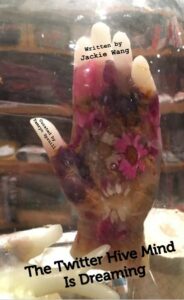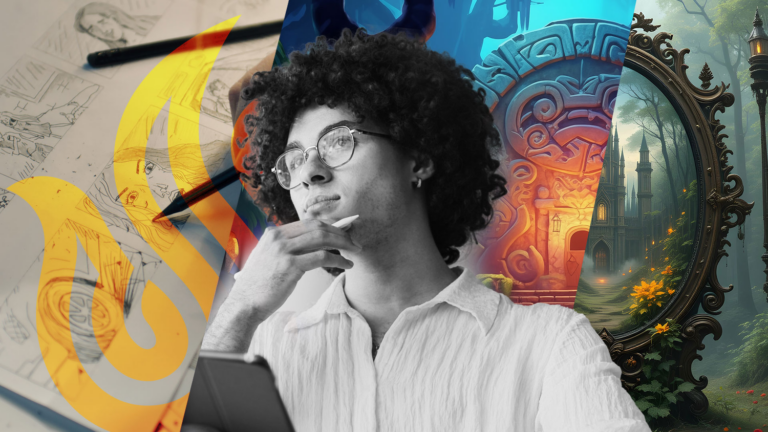Tamryn Spruill explains how working with other creative minds keeps the artistic fires burning. In addition to teaching at USV, Tamryn is a contributing writer/editor at Golden State of Mind and her work has appeared in Teen Vogue, Mask magazine, and other publications. In 2012, she founded Robocup Press, an indie publisher of hybrid/cross-genre books and she teaches college English, literature, and creative writing. In her copious spare time, she is finishing a novel.
Collaboration is essential for creative professionals, especially those who spend a great deal of time working alone. As a writer, publisher, and online instructor, I spend the majority of my days working in isolation. Yet, I consider myself lucky to enjoy solitude because I am not one who can endure the distractions of writing, grading student papers, or designing books in a café!
Being alone all the time is not necessarily conducive to artistic growth. I seek and accept opportunities to collaborate with others. Sometimes, this comes in the form of a magazine editor making suggestions for revision and, at other times, it is me making those requests of authors whose books I’ve selected for publication by Robocup Press—the indie press I founded in 2012.
 A most unusual Robocup Press collaboration began in late 2016, culminating in the upcoming publication of The Twitter Hive Mind Is Dreaming—a poetry collection written by Jackie Wang, a Harvard PhD candidate, and curated by me. The book will be released this summer. In the “Editor’s Note” at the beginning of the book, I explain the formation of the project this way:
A most unusual Robocup Press collaboration began in late 2016, culminating in the upcoming publication of The Twitter Hive Mind Is Dreaming—a poetry collection written by Jackie Wang, a Harvard PhD candidate, and curated by me. The book will be released this summer. In the “Editor’s Note” at the beginning of the book, I explain the formation of the project this way:
Dear Reader:
I do not recall when my social media orbit first crossed into Jackie Wang’s. But when our rings overlapped on Twitter, I was immediately exhilarated by the timelessness and beauty of her language—not to mention the erudition of her insights into topics ranging from personal to political.
The 140-character limitation on tweets leads many not only to adapt to brevity but also to become lazy with words. Jackie’s tweets, however, demonstrate that a character limit does not need to be a straightjacket on expression. Instead, the structure can foster linguistic efficiency in which every. word. counts.
It quickly became obvious to me that Jackie’s tweets were poetry.
So mesmerized was I by her micro-poems that I sent a direct message to her in late 2016 with a request I felt sure she might find odd, if not invasive: May I turn your tweets into a poetry collection?
Jackie enthusiastically agreed to let me play with what she labeled her “word scraps.”
Soon after we began communicating, I discovered that our birthdays are just a few days apart—under the astrological sign of Aquarius. To me, this explained the organic creative symbiosis that resulted in very few discussions about the manuscript.Jackie granted me permission to gather her tweets and arrange them into a cohesive, poetic narrative. She gifted me with the freedom to curate her micro-poems in a way that made artistic sense to me.
In “The Twitter Hive Mind Is Dreaming”, all words are Jackie Wang’s, including the title of the collection, the dedication, the author’s bio, and her acknowledgments. Each micro-poem that appears in the collection was tweeted by Jackie between October 2016 and early 2017.
These individual micro-poems are presented in their entirety, just as Jackie originally tweeted them. I organized them according to theme. Thus, the only text I contributed to the manuscript are the bold sub headings that label each themed section: dreamscape, in the stacks, deep dive into the mind, umbrae, cacoethes, and luminance. (The italicized text that appears beneath each bold subheading is Jackie’s.)
Finally, words that were abbreviated in Jackie’s tweets to accommodate Twitter’s character limitation have been spelled out in this manuscript: “ur” became “your,” “Af Am” became African-American, “&” became “and,” and so on.
It is my hope that you will find Jackie Wang’s collection of once-tweeted micro-poems to be as hypnotic and as evocative as I do. Her mind is certainly one to take seriously.
Tamryn Spruill, Founder/Editor-In-Chief
Robocup Press
For the book cover, Jackie sent a file to me containing dozens of intriguing photos she’d taken throughout her travels in recent years. I selected the photograph that best reflects the enigmatic tone of the book and designed the cover around it. The back of the book is a fuchsia color that matches the flowers in Jackie’s photograph. Blurbs by authors endorsing the book appear in white lettering on the back.
Hands down, “The Twitter Hive Mind Is Dreaming” is one of the most exhilarating collaborations I’ve been involved with, for reasons both personal and creative. Ruminating on Jackie’s “word scraps” for months allowed me a rare glimpse into the themes that dominate her unconscious mind most frequently. This inspired me to search more consistently for patterns and themes in my own dreams. During this project, I learned that Jackie values organic process and natural development over “creative control,” and I am forever grateful for the trust and faith she placed in me to honor a shared creative vision.
For all of the joy of this collaboration, however, others have been the exact opposite: laborious, stressful, and undermined by rigidity of vision, indecision, and/or diva-like demands. I learned important lessons from even my worst collaborative experiences—lessons I will never repeat! A few bad experiences do not erase the ways I’ve benefitted from collaboration overall. Here are seven lessons I’ve learned about collaborating and keeping the creative fires burning:
1. Trust your instincts. Even if you are not sure why a person or situation doesn’t sit right with you, trust your instincts anyway. My most problematic collaborations came about because I did not trust mine. More than just being unpleasant working experiences, Collaborations Gone Wrong can lead to financial losses as well.
2. Look for art in the mundane. While riding a bus or trolley, walking a city street, hiking a trail, taking care of business at a municipal building, using a public restroom, or sipping a beverage at your favorite cafe, take a moment to be present in your surroundings. This will allow you to see or hear things that otherwise might go unnoticed. In the most ordinary places of life—even on Twitter (!!!)—you could find the beginnings to a new project or a solution to one that has you stuck.
3. Say yes to everything. All creative opportunities do not come with monetary gain. But visibility and collaborations—especially with creative professionals you admire—should be considered investments that will pay off later. Say yes to as many things as you can, and only say no when: 1) your instincts warn you against a project or person; 2) the project goes against your moral, ethical or religious beliefs; or 3) you are busy with so many work and/or personal demands that to add something new would leave you stressed and run down.
4. Collaborate with the dead. Séance and cemetery not required! But to look back often means to create forward. So much can be learned from dead masters and living legends! Read their works. Watch their films. View their art. Read autobiographies and interviews about their lives and artistic processes. Watch documentaries. Feed your brain creative nutrients that can inspire new projects and prepare you for future collaborations.
5. Make your work visible. If you don’t have a personal website, create one, or use social media to your advantage. Visual artists, for example, can use Instagram as an online portfolio, while musicians can use SoundCloud or other sites. Collaborations form when one creative mind stumbles upon the work of another, as happened with me and Jackie Wang on Twitter.
6. Make yourself available. If people are unable to contact you, they will have no way to offer you opportunities! As a writer, a bio that includes links to my website and Twitter page are included with my published works. In fact, many of my professional successes—from writing for Teen Vogue to being invited to do radio interviews—came about because people could easily find me on Twitter. At least for writers and indie publishers, Twitter has been an unlikely, but much appreciated and invaluable networking hub.
7. Value even the scraps. In other words, keep the random pieces that resonate with you, even if they do not relate in any way to your current projects. Whether it’s a single sentence, a sketch, a chord progression, or rough idea for a future work, write it down, draw it, record it, and save it. Nothing may come of these scraps immediately, if at all. But the possibility always exists that a single sentence will lead to a novel, a simple sketch to a comic book, a chord progression to a song on a full album. In Jackie Wang’s case, scraps were pieced together into a poetry collection called “The Twitter Hive Mind Is Dreaming”.


